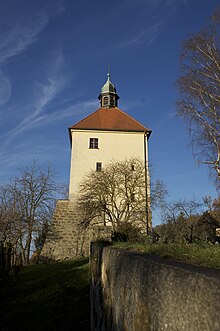Konrad Max Kunz
Konrad Max Kunz (born April 29, 1812 in Schwandorf ; † August 3, 1875 in Munich ) was the choir director and head of incidental music at the royal court and national theater in Munich. He is considered one of the "fathers of German male singing" and has created numerous compositions for male choirs that have been sung almost all over Europe, America and Australia. In 1860 Kunz composed the melody of the later Bavarian anthem .
Life
Kunz was born as the son of the Schwandorf city towerer Franz Michael Kunz and his wife Barbara. Metz, born. He received his first music lessons from his father, in keeping with the tower tradition. His younger brother Christian Kunz (1814–1887) was from 1845 until his death the town tower and organ builder in Rain am Lech . His sister carried on the tower tradition in Schwandorf.
As a child, Konrad Max Kunz played with his father in the taverns and at the festivals around Schwandorf to dance. After high school, Kunz moved to the Lyceum in Amberg and studied theology. There he taught from 1829 to 1832 Johann Evangelist Deischer as music prefect. He then went to the University of Munich and began to study law in 1833, which he finished without a degree in 1837 because he turned to music. In 1840 he was one of the founding members of the men's choir "Münchner Liedertafel", in which he also worked as first choirmaster until 1852 and composed and arranged numerous choral songs. The management of the singing festivals in Freising in July 1844 and in Regensburg in 1847 made him well known beyond the region.
In 1845 , on the recommendation of the composer Franz Lachner , the court theater director August von Frays employed him as choir conductor of the Royal State Opera in Munich, which position he held until his retirement (after 1870) and where he succeeded in attaining the level of the “court theater choir “To improve, which was particularly beneficial to the Wagner premieres in the 1960s under Bülow. In 1855 Kunz also took over the management of the Munich “Citizens 'Singer Guild” until 1869. Kunz received the most important honor in 1863 when he became conductor of the Wolfratshausen Singing Festival in August and the first conductor of the Bavarian Singers' Association in September.
The musician died in the Bavarian capital in 1875 and was buried there in the southern cemetery. In order to honor his great achievements in male singing, an initiative of the Bavarian Singers 'Association and the Munich Singers' Cooperative was formed for the erection of a representative grave monument, which consisted of a bust of Kunz executed by Schwanthaler in white marble and which was celebrated at his grave in October 1878 was revealed. The transfer of his remains to the Schwandorf municipal cemetery took place on August 7, 1979, where a bust now adorns his grave. To commemorate the glockenspiel on the lower market square in Schwandorf plays the Bavarian anthem daily at 11 a.m. and 5 p.m.
The house where he was born, the Blasturm, is a watchtower of the former Schwandorf fortifications and is located on the driveway to the vineyard.
Carl Spitzweg , the painter of the idyll, painted the blow tower around 1858 while passing through. He called the oil painting Schwandorf City Tower in the Moonlight.
On the occasion of the 150th anniversary of the first performance of the Bavarian anthem, the city of Schwandorf launched a new culture and music festival with the “Konrad Max Kunz Days” in April 2010.
literature
- Hyacinth Holland: Kunz, Konrad Max . In: Allgemeine Deutsche Biographie (ADB). Volume 17, Duncker & Humblot, Leipzig 1883, p. 399 f.
Web links
- Works by and about Konrad Max Kunz in the catalog of the German National Library
- Works by and about Konrad Max Kunz in the German Digital Library
- http://www.konrad-max-kunz-tage.de
- Family history Kunz (PDF; 67 kB)
swell
- Documents from the Schwandorf Tourist Office
- Thomas Göttinger: Bavaria's greatest hit - Konrad Max Kunz and the Bavarian anthem. Schwandorf 2007.
Individual evidence
- ↑ Thomas Göttinger: Bavaria's greatest hit: Konrad Max Kunz and the Bavarian anthem. 2010, ISBN 3839132940 , pages 44 and 45; Digital scan
| personal data | |
|---|---|
| SURNAME | Kunz, Konrad Max |
| BRIEF DESCRIPTION | German composer of the Bavarian anthem |
| DATE OF BIRTH | April 29, 1812 |
| PLACE OF BIRTH | Schwandorf |
| DATE OF DEATH | August 3, 1875 |
| Place of death | Munich |

